-
Posts
22 -
Joined
-
Last visited
Content Type
Profiles
Forums
Events
Posts posted by CBETO3AP
-
-
-
Hi
I work on Hristo PCB, member of this community.http://diyfan.blogspot.com.es/2012/02/adjustable-lab-power-supply.html
By changing the shunt, as I feared, the current regulation is very slow, now I'm looking solution without increasing the shunt.No load through the PCB and is cut so.
-
Yes, I have been forced to change the shunt resistor. Now this place metal shunt 10A / 0.1V.Thus I am saving me 1.4V. Plus something like 0.5V to have 10 emiter resistor in parallel. Low Vdrop is because the shunt is bolted directly to the output. And the sensing cable to the out.
-
-
BD140 driver emiter current tested - 85mA max at 10A load
 (200mA expected)
(200mA expected)The peak voltage of this toroid transformer (filtered, no load) - 38v, i modifed the secondary from 12v/25A to 24V/12.5A
741 opamps is on negative -5.6V (4.7V in my case) supply, ofcorce
The LM311 is a comparator I know, will see...
"Then you must buy a few hundred transistors, test their gain and use only the best ones" I usually buy scrap and test

"Maybe you calculated with "typical" current gain" nop, i calculate well and have some luck with the gain

-
Limited by the 24V / 300W transformer this will give out 24 or 20V-10A.
I bought fake China MC34071 and now I'm doing tests with UA741, the truth is that there are going pretty well. I expect a TLE2141AIP and if it is the original'll ask the rest. What I will possibly do after testing is remaking the scheme to put LM311, open collector 50V out at currents as 50mA. This and a more powerful transformer allow me more output. The use of such power is for example the CNC machine cutting expanded polystyrene with hot wire.p.p. By my calculations with 1 or 2 driver transistors BD140 is enough.
-
-
-
I have a doubt. What is the function of zener D1 (D3) of 10v, why is there?
-
First thanks for the comments.
Just I get started to modify the scheme and did not have much time to review and change everything I need. Also I expect your comments. It is the first time I use Proteus. I always try to build recycling scrap, bought mainly old PCB 1 € / 1kg. The TIP35C have them in large quantities, with pin collector cut but not be a problem. The toroid transformer is 2x12v / 300w, C1 will probably be 2x18000uf, my friend has 4 also scrap. So far I have not decided, we'll see.
What I had not thought is the reverse bias of BD140, I'll have to protect it, thanks for advice. BD139 is 12W 1.5A, TIP35C gain to 1.5A is 25-50. If consumed 10A output to 0V, in the collector BD135 would have 0.4A for 30Vce = 12W. I'm wrong? I know, it is at the limit... You can suggest another transistor to facilitate me?Why R7 is the wrong value for this configuration???
-
-
Hi audioguru.
Now that I'm done with the other conversation I would like to continue this.
To me the truth I do not like to limit the transistor with a resistor if possible. You do not think it is possible to hold without burning? From what I see in the manufacturer PDF, gain low wen collector current up. I would try immediately if possible, but for now have only the PCB, I hope the components, and am content with theory.
Please excuse my bad English, it is the google translator..
-
The truth is that I respond with fear, you're very reluctant to my comments and I need not bother you.
For me it is obvious that feedback must be in the output of the circuit. I suspected but was not so obvious that the C11, C12 are very large but audioguro corrected me and then I saw that could cause the problem.
You need to know the why of each component in your circuit to reason and improve it. This is sometimes quite difficult, especially when you copied the outline of another without understanding. I'm not electronics guru, so I entered this community, to continue to learn from those who know more. Here I ended the conversation with you, you obviously do not need my help. -
If I'm wrong about something (of course this can be and prefer to see in the community), there is audioguru, who always find the error and tell, and always right, which I respect a lot. This is already on frame of contecst so I would like to haver not said anything about your "work of art". Practically not get anything more than what can be done with the LM317, LM337. In fact you've gotten worse stability, thereby constructively we have discussed before. I will not bother to draw a circuit totally different from yours, it's easier to grab any circulating on the internet and we would have the same result as minimum. Everything I've said has been with good intentions, so far. I am sorry that you've had that bad.
-
Hihi because I'm lazy. I just grab the first Internet scheme as an example. I do not know who and why has put diodes. The potentiometer is understood. And of course, LM317, LM337 are more appropriate. It's just as basic example.
-
Your change adds significant oscillations to my simulation output on the positive side of things.
C11 and C12 slow down the outputs too much, causing poor voltage regulation if the load current changes of if the load current is modulated. The circuit will have serious overshoots and might oscillate.
If you like to experiment try This
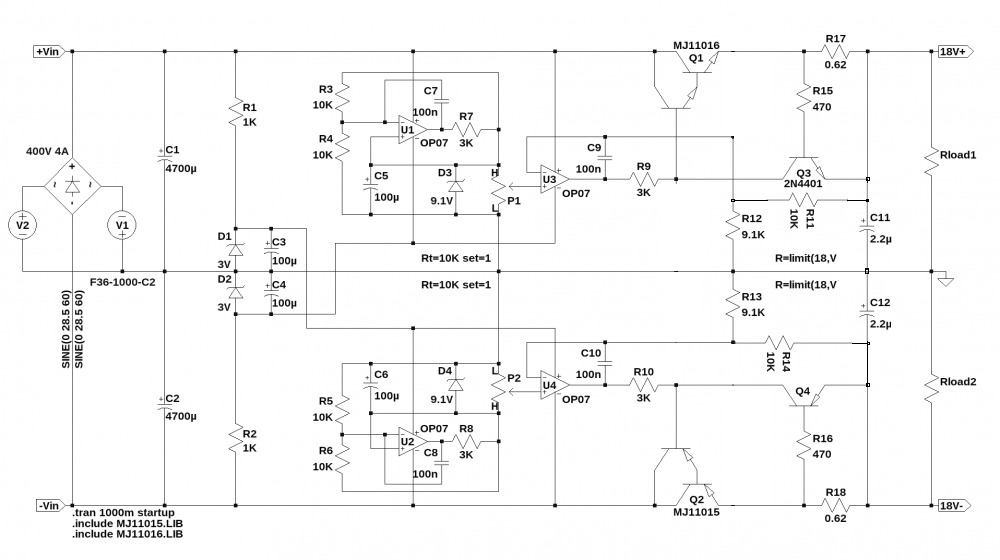
"I have come up with what seems a fairly decent power supply using a minimal of parts that are easily obtainable and cheap. The idea is to have a power supply for working with dual supply op amps."
A very basic and stable example. The op-amp burn equal to 1A or 5A.
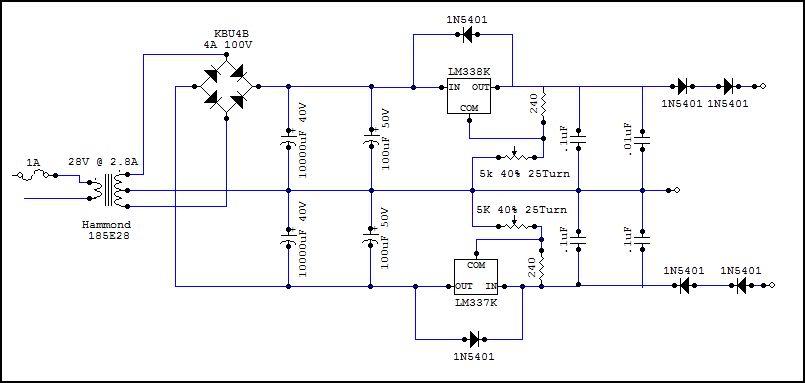
Very good work
-
I am glad you are happy with what has been achieved. I did not mean to criticize, simply insignificant change without complicating the circuit can eliminate the fall of 0.62v when consumption is 1A. The audioguru also right, C11 and C12 better be around 0.XXXuF.
Without wishing to disturb: Svetozar
-
-
I can see myself forced to put a resistor 10R, but according to manufacturer seems not.
To test the reaction of the discharge transistor of a TES I set I = 0.01A and U = 15V. When connecting a 0.1W LED Light Peak is not noticeable, just lights. I know it's something old test this way, but I did over 25 years ago. I would love to get the same but with large capacitors in the output. This might not be the most appropriate transistor and connection. It is the first thing that occurred to me, basic and seems to work. The idea is to eliminate the charge on the capacitors even in the device we tested when something goes wrong to protect circuits behind them.
-
Thanks for the warning. I actually first saw Hristo scheme, and which I will be adapt to 0-20V 0-10A.
Clear that one of the purposes of this circuit is to maintain a stable output voltage, but how it would behave if the load is 9A pulses? My idea for laboratory power supply is a device in which the pulses of output V are kept to a minimum in all conditions, and when consumption exceeds the set limits - lowering out Instantly. So I think an improvement add a large capacitor on the output and the possibility of discharge Instantly. And if they are not really necessary discharge transistor it is, to discharge the capacitors in the device that we connected to our source of power. Here I leave as an example an old but very good Bulgarian scheme which implements the discharge transistor.
-
Hi all
I really like this scheme and I am thinking about reproducing it for my own use. Even though, there is something that I miss and it's that the capacitors are too small in the out and I need them to be bigger. I think add a transistor in order to avoid problems with discharge of 0.1F cap.
Svetozar



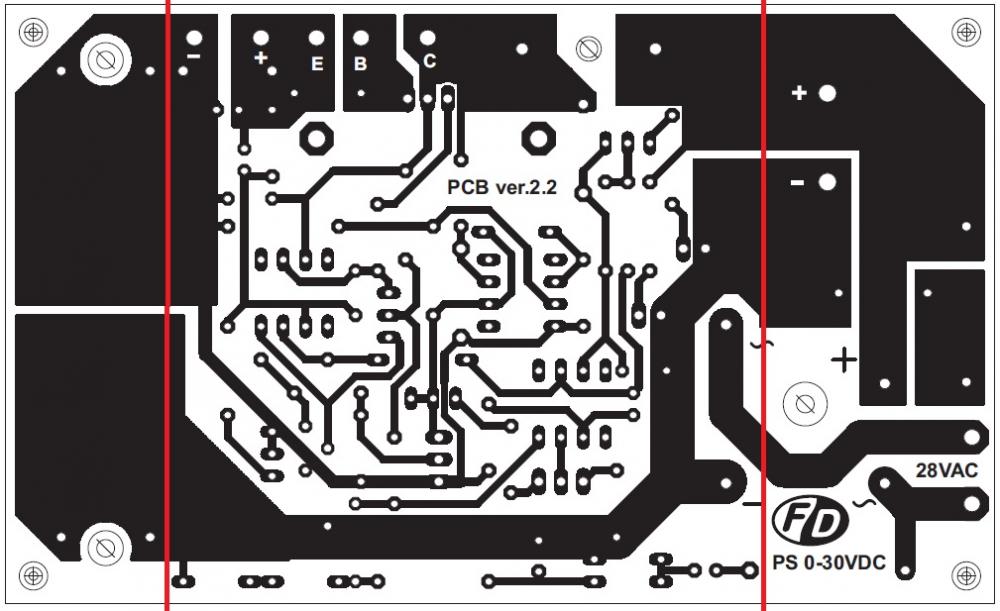

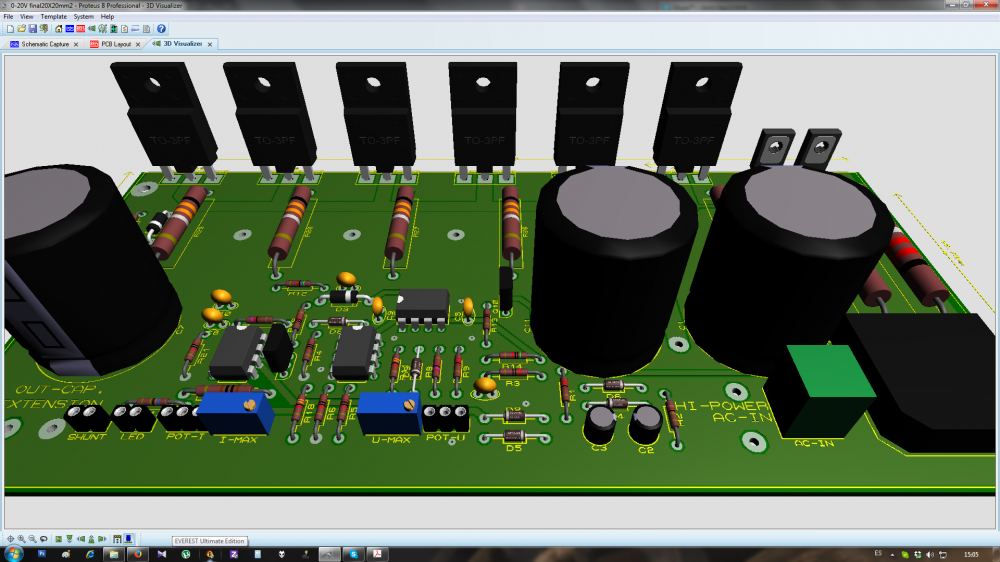
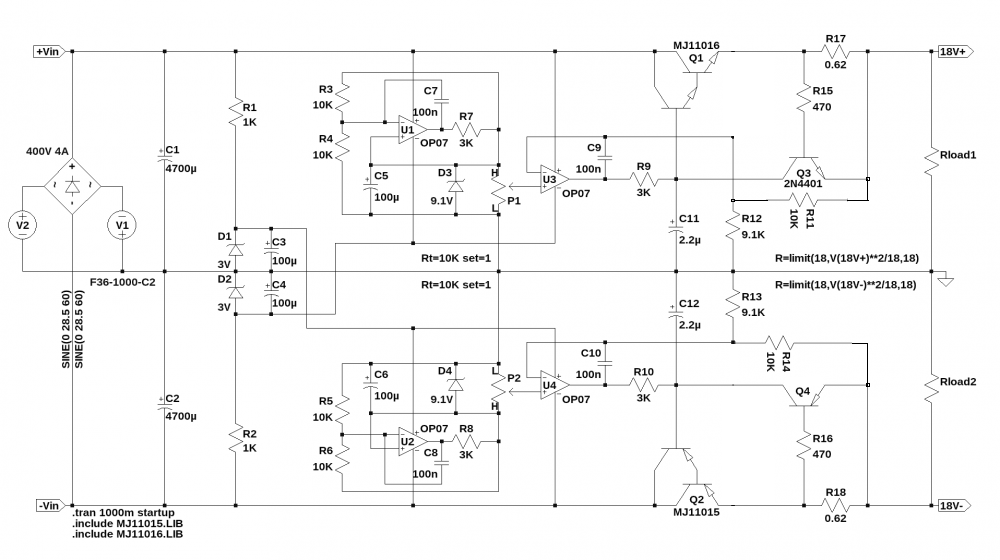
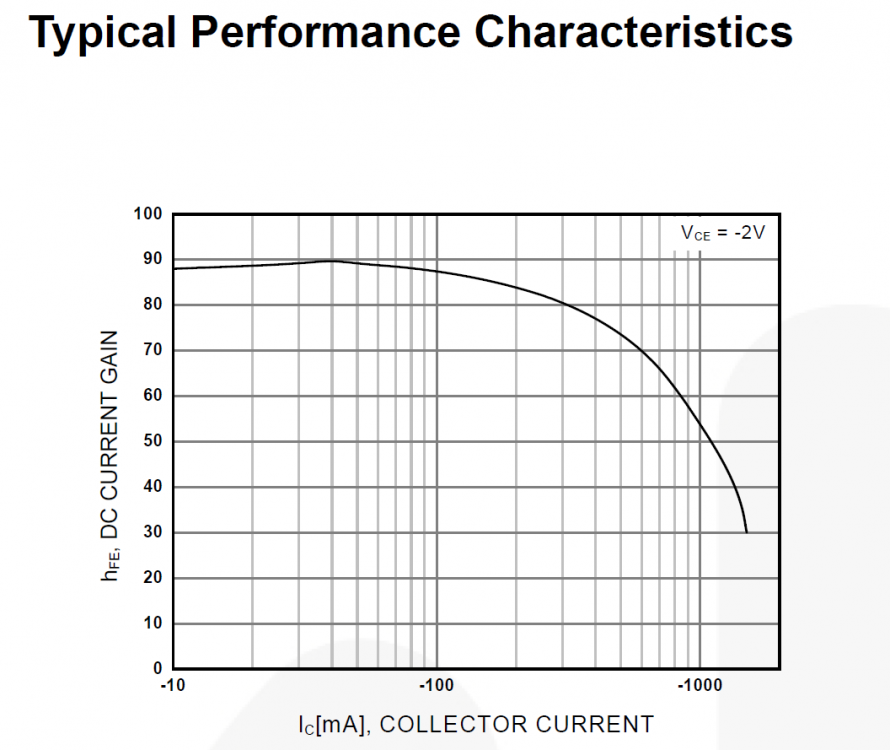
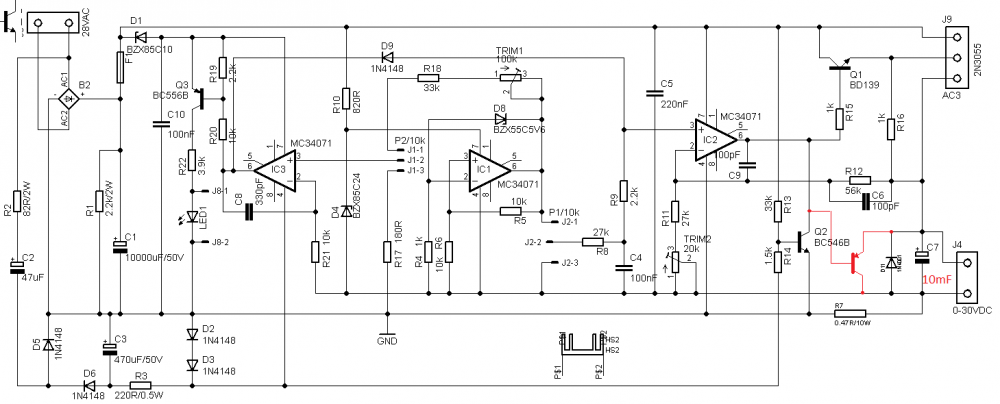
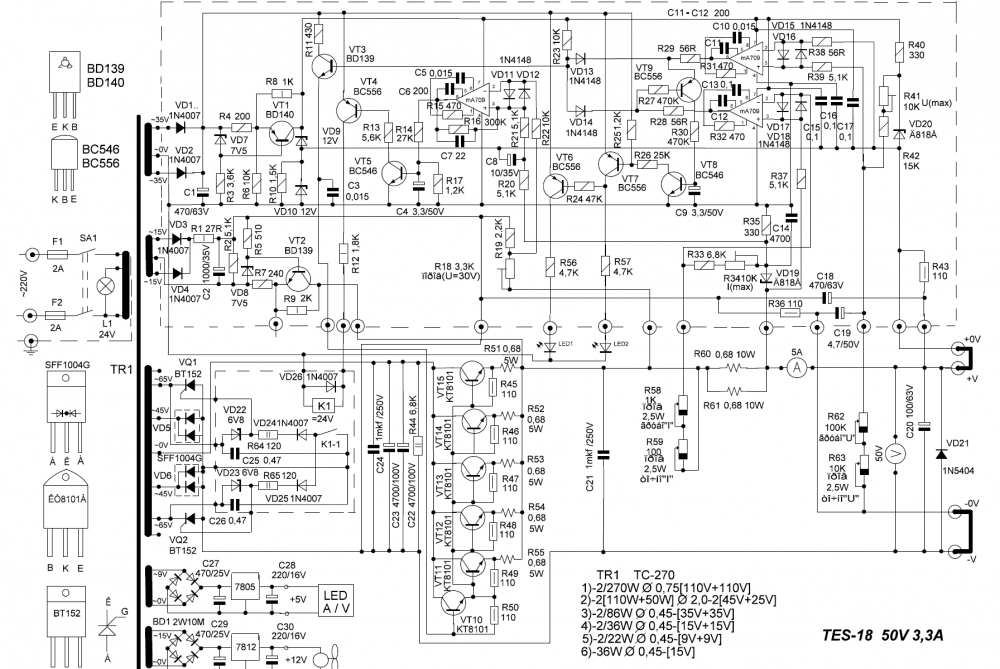
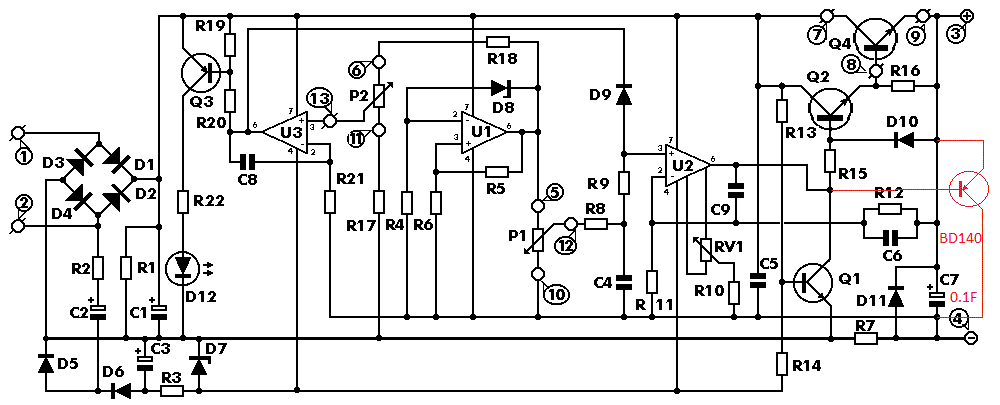
0-30 VDC Stabilized Power Supply 0.002-3 A
in Power Electronics
Posted